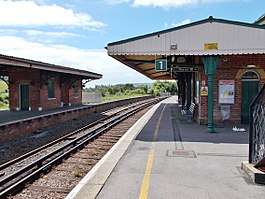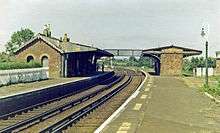Brading railway station
| Brading | |
|---|---|
 | |
| Location | |
| Place | Brading |
| Local authority | Isle of Wight |
| Coordinates | 50°40′41″N 1°08′20″W / 50.678°N 1.139°WCoordinates: 50°40′41″N 1°08′20″W / 50.678°N 1.139°W |
| Grid reference | SZ609868 |
| Operations | |
| Station code | BDN |
| Managed by | Island Line |
| Number of platforms | 1 |
| DfT category | F2 |
|
Live arrivals/departures, station information and onward connections from National Rail Enquiries | |
| Annual rail passenger usage* | |
| 2012/13 |
|
| 2013/14 |
|
| 2014/15 |
|
| 2015/16 |
|
| 2016/17 |
|
| History | |
| Key dates | Opened 23 August 1864 |
| Listed status | |
| Listed feature | Brading Railway Station Main Building |
| Listing grade | Grade II listed |
| Entry number | 1034363[1] |
| Added to list | 14 April 1986 |
| National Rail – UK railway stations | |
| * Annual estimated passenger usage based on sales of tickets in stated financial year(s) which end or originate at Brading from Office of Rail and Road statistics. Methodology may vary year on year. | |
|
| |
Brading railway station is a Grade II listed[1] railway station serving Brading on the Isle of Wight. It is located on the Island Line from Ryde to Shanklin. Owing to its secluded location and single operational platform, it is one of the quietest stations on the Island.
History
The station was opened in 1864 by the Isle of Wight Railway on the Ryde-Shanklin-Ventnor line. In 1882 it became a junction station, when the Brading-Bembridge branch line as part of the Brading Haven reclamation scheme. The branch line closed to passengers in 1953 and completely in 1957.
Under Southern Railway ownership, the passing loop was extended southwards from Brading to Sandown in 1927, forming a second section of double track on the Island Line.[2]
By the early 1980s Brading was one of the last stations on British Rail to retain gas lighting. In 1985 this changed; although the fittings were retained, they were converted from gas to mercury vapour usage. A few survive in 2010, now using compact fluorescent bulbs.

Brading signalbox closed on 28 October 1988. At this time, the passing loop at Brading station was removed, meaning that only one platform remained in use. This meant the end of 30-minute interval service on the line for over 25 years.[3] By 1998 the signal box and branch platforms were very overgrown and the buildings were threatened with demolition. Brading Town Council stepped in and with the help of grants and volunteers, from 2002, different parts of the station were gradually being reopened, on March 2010 the whole of the station and signal box was fully opened to the public for the first time in 40 years. The restored Grade II listed[4] signal box and station buildings are now home to a heritage centre, cafe, museum and a Tourist Information Point.[5] The main station building is Grade II listed,[1] as is the station building on the east platform,[6] the footbridge,[7] and the station house.[8]
Facilities
.jpg)
In August 2007 Brading Town Council announced a plan to revamp the exterior of the station buildings and former signal box.[9] The station building houses a café, visitors' centre and bike hire shop. There is no railway staff presence at the station, tickets are issued from an automatic machine or from the guard on board the train. Trains for both directions leave from the same platform, as the line is presently single track.
In an online discussion, South West Trains' Managing Director Stewart Palmer stated that the company hoped Network Rail might reinstate the passing loop at Brading station by the middle of 2014, although the exact timescale depends on the line's resignalling.[10]
| Preceding station | Following station | |||
|---|---|---|---|---|
| Sandown | Island Line (train company) Island Line (railway line) |
Smallbrook Junction (steam operating days only) | ||
| Ryde St Johns Road | ||||
| Disused railways | ||||
| Terminus | British Rail Southern Region IoWR :Bembridge branch |
St Helens | ||
References
- 1 2 3 Historic England, "Brading Railway Station Main Building (1034363)", National Heritage List for England, retrieved 26 June 2017
- ↑ Hardy, Brian (2003). Tube Trains on the Isle of Wight. Harrow Weald, Middlesex: Capital Transport. p. 9. ISBN 1-85414-276-3.
- ↑ Hardy, Brian (2003). Tube Trains on the Isle of Wight. Harrow Weald, Middlesex: Capital Transport. p. 37. ISBN 1-85414-276-3.
- ↑ Historic England, "Brading Railway Station Signal Box (1034364)", National Heritage List for England, retrieved 26 June 2017
- ↑ "Brading Station Visitor Centre". Retrieved 4 April 2017.
- ↑ Historic England, "Brading Railway Station Main Building on East Platform (1291364)", National Heritage List for England, retrieved 26 June 2017
- ↑ Historic England, "Brading Railway Station Footbridge (1365330)", National Heritage List for England, retrieved 26 June 2017
- ↑ Historic England, "Station House (1219685)", National Heritage List for England, retrieved 26 June 2017
- ↑ The News, Portsmouth, 3 August 2007
- ↑ "South West Trains: Performance". 17 February 2009. Archived from the original on 31 August 2009. Retrieved 17 February 2009. Question 112
External links
| Wikimedia Commons has media related to Brading railway station. |
- Train times and station information for Brading railway station from National Rail